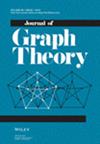求助PDF
{"title":"图划分为2连通子图的新不变量","authors":"Michitaka Furuya, Masaki Kashima, Katsuhiro Ota","doi":"10.1002/jgt.23242","DOIUrl":null,"url":null,"abstract":"<div>\n \n <p>Let <span></span><math>\n <semantics>\n <mrow>\n \n <mrow>\n <mi>G</mi>\n </mrow>\n </mrow>\n </semantics></math> be a graph of order <span></span><math>\n <semantics>\n <mrow>\n \n <mrow>\n <mi>n</mi>\n </mrow>\n </mrow>\n </semantics></math>. For an integer <span></span><math>\n <semantics>\n <mrow>\n \n <mrow>\n <mi>k</mi>\n \n <mo>≥</mo>\n \n <mn>2</mn>\n </mrow>\n </mrow>\n </semantics></math>, a partition <span></span><math>\n <semantics>\n <mrow>\n \n <mrow>\n <mi>P</mi>\n </mrow>\n </mrow>\n </semantics></math> of <span></span><math>\n <semantics>\n <mrow>\n \n <mrow>\n <mi>V</mi>\n \n <mrow>\n <mo>(</mo>\n \n <mi>G</mi>\n \n <mo>)</mo>\n </mrow>\n </mrow>\n </mrow>\n </semantics></math> is called a <span></span><math>\n <semantics>\n <mrow>\n \n <mrow>\n <mi>k</mi>\n </mrow>\n </mrow>\n </semantics></math>-proper partition of <span></span><math>\n <semantics>\n <mrow>\n \n <mrow>\n <mi>G</mi>\n </mrow>\n </mrow>\n </semantics></math> if every <span></span><math>\n <semantics>\n <mrow>\n \n <mrow>\n <mi>P</mi>\n \n <mo>∈</mo>\n \n <mi>P</mi>\n </mrow>\n </mrow>\n </semantics></math> induces a <span></span><math>\n <semantics>\n <mrow>\n \n <mrow>\n <mi>k</mi>\n </mrow>\n </mrow>\n </semantics></math>-connected subgraph of <span></span><math>\n <semantics>\n <mrow>\n \n <mrow>\n <mi>G</mi>\n </mrow>\n </mrow>\n </semantics></math>. This concept was introduced by Ferrara et al., and Borozan et al. gave minimum degree conditions for the existence of a <span></span><math>\n <semantics>\n <mrow>\n \n <mrow>\n <mi>k</mi>\n </mrow>\n </mrow>\n </semantics></math>-proper partition. In particular, when <span></span><math>\n <semantics>\n <mrow>\n \n <mrow>\n <mi>k</mi>\n \n <mo>=</mo>\n \n <mn>2</mn>\n </mrow>\n </mrow>\n </semantics></math>, they proved that if <span></span><math>\n <semantics>\n <mrow>\n \n <mrow>\n <mi>δ</mi>\n \n <mrow>\n <mo>(</mo>\n \n <mi>G</mi>\n \n <mo>)</mo>\n </mrow>\n \n <mo>≥</mo>\n \n <msqrt>\n <mi>n</mi>\n </msqrt>\n </mrow>\n </mrow>\n </semantics></math>, then <span></span><math>\n <semantics>\n <mrow>\n \n <mrow>\n <mi>G</mi>\n </mrow>\n </mrow>\n </semantics></math> has a 2-proper partition <span></span><math>\n <semantics>\n <mrow>\n \n <mrow>\n <mi>P</mi>\n </mrow>\n </mrow>\n </semantics></math> with <span></span><math>\n <semantics>\n <mrow>\n \n <mrow>\n <mo>∣</mo>\n \n <mi>P</mi>\n \n <mo>∣</mo>\n \n <mo>≤</mo>\n \n <mfrac>\n <mrow>\n <mi>n</mi>\n \n <mo>−</mo>\n \n <mn>1</mn>\n </mrow>\n \n <mrow>\n <mi>δ</mi>\n \n <mrow>\n <mo>(</mo>\n \n <mi>G</mi>\n \n <mo>)</mo>\n </mrow>\n </mrow>\n </mfrac>\n </mrow>\n </mrow>\n </semantics></math>. Later, Chen et al. extended the result by giving a minimum degree sum condition for the existence of a 2-proper partition. In this paper, we introduce two new invariants of graphs <span></span><math>\n <semantics>\n <mrow>\n \n <mrow>\n <msup>\n <mi>σ</mi>\n \n <mo>*</mo>\n </msup>\n \n <mrow>\n <mo>(</mo>\n \n <mi>G</mi>\n \n <mo>)</mo>\n </mrow>\n </mrow>\n </mrow>\n </semantics></math> and <span></span><math>\n <semantics>\n <mrow>\n \n <mrow>\n <msup>\n <mi>α</mi>\n \n <mo>*</mo>\n </msup>\n \n <mrow>\n <mo>(</mo>\n \n <mi>G</mi>\n \n <mo>)</mo>\n </mrow>\n </mrow>\n </mrow>\n </semantics></math>, which are defined from degree sum of particular independent sets. Our result is that if <span></span><math>\n <semantics>\n <mrow>\n \n <mrow>\n <msup>\n <mi>σ</mi>\n \n <mo>*</mo>\n </msup>\n \n <mrow>\n <mo>(</mo>\n \n <mi>G</mi>\n \n <mo>)</mo>\n </mrow>\n \n <mo>≥</mo>\n \n <mi>n</mi>\n </mrow>\n </mrow>\n </semantics></math>, then with some exceptions, <span></span><math>\n <semantics>\n <mrow>\n \n <mrow>\n <mi>G</mi>\n </mrow>\n </mrow>\n </semantics></math> has a 2-proper partition <span></span><math>\n <semantics>\n <mrow>\n \n <mrow>\n <mi>P</mi>\n </mrow>\n </mrow>\n </semantics></math> with <span></span><math>\n <semantics>\n <mrow>\n \n <mrow>\n <mo>∣</mo>\n \n <mi>P</mi>\n \n <mo>∣</mo>\n \n <mo>≤</mo>\n \n <msup>\n <mi>α</mi>\n \n <mo>*</mo>\n </msup>\n \n <mrow>\n <mo>(</mo>\n \n <mi>G</mi>\n \n <mo>)</mo>\n </mrow>\n </mrow>\n </mrow>\n </semantics></math>. We completely determine exceptional graphs. This result implies both of results by Borozan et al. and by Chen et al. Moreover, we obtain a minimum degree product condition for the existence of a 2-proper partition as a corollary of our result.</p>\n </div>","PeriodicalId":16014,"journal":{"name":"Journal of Graph Theory","volume":"109 4","pages":"505-513"},"PeriodicalIF":1.0000,"publicationDate":"2025-03-27","publicationTypes":"Journal Article","fieldsOfStudy":null,"isOpenAccess":false,"openAccessPdf":"","citationCount":"0","resultStr":"{\"title\":\"New Invariants for Partitioning a Graph Into 2-Connected Subgraphs\",\"authors\":\"Michitaka Furuya, Masaki Kashima, Katsuhiro Ota\",\"doi\":\"10.1002/jgt.23242\",\"DOIUrl\":null,\"url\":null,\"abstract\":\"<div>\\n \\n <p>Let <span></span><math>\\n <semantics>\\n <mrow>\\n \\n <mrow>\\n <mi>G</mi>\\n </mrow>\\n </mrow>\\n </semantics></math> be a graph of order <span></span><math>\\n <semantics>\\n <mrow>\\n \\n <mrow>\\n <mi>n</mi>\\n </mrow>\\n </mrow>\\n </semantics></math>. For an integer <span></span><math>\\n <semantics>\\n <mrow>\\n \\n <mrow>\\n <mi>k</mi>\\n \\n <mo>≥</mo>\\n \\n <mn>2</mn>\\n </mrow>\\n </mrow>\\n </semantics></math>, a partition <span></span><math>\\n <semantics>\\n <mrow>\\n \\n <mrow>\\n <mi>P</mi>\\n </mrow>\\n </mrow>\\n </semantics></math> of <span></span><math>\\n <semantics>\\n <mrow>\\n \\n <mrow>\\n <mi>V</mi>\\n \\n <mrow>\\n <mo>(</mo>\\n \\n <mi>G</mi>\\n \\n <mo>)</mo>\\n </mrow>\\n </mrow>\\n </mrow>\\n </semantics></math> is called a <span></span><math>\\n <semantics>\\n <mrow>\\n \\n <mrow>\\n <mi>k</mi>\\n </mrow>\\n </mrow>\\n </semantics></math>-proper partition of <span></span><math>\\n <semantics>\\n <mrow>\\n \\n <mrow>\\n <mi>G</mi>\\n </mrow>\\n </mrow>\\n </semantics></math> if every <span></span><math>\\n <semantics>\\n <mrow>\\n \\n <mrow>\\n <mi>P</mi>\\n \\n <mo>∈</mo>\\n \\n <mi>P</mi>\\n </mrow>\\n </mrow>\\n </semantics></math> induces a <span></span><math>\\n <semantics>\\n <mrow>\\n \\n <mrow>\\n <mi>k</mi>\\n </mrow>\\n </mrow>\\n </semantics></math>-connected subgraph of <span></span><math>\\n <semantics>\\n <mrow>\\n \\n <mrow>\\n <mi>G</mi>\\n </mrow>\\n </mrow>\\n </semantics></math>. This concept was introduced by Ferrara et al., and Borozan et al. gave minimum degree conditions for the existence of a <span></span><math>\\n <semantics>\\n <mrow>\\n \\n <mrow>\\n <mi>k</mi>\\n </mrow>\\n </mrow>\\n </semantics></math>-proper partition. In particular, when <span></span><math>\\n <semantics>\\n <mrow>\\n \\n <mrow>\\n <mi>k</mi>\\n \\n <mo>=</mo>\\n \\n <mn>2</mn>\\n </mrow>\\n </mrow>\\n </semantics></math>, they proved that if <span></span><math>\\n <semantics>\\n <mrow>\\n \\n <mrow>\\n <mi>δ</mi>\\n \\n <mrow>\\n <mo>(</mo>\\n \\n <mi>G</mi>\\n \\n <mo>)</mo>\\n </mrow>\\n \\n <mo>≥</mo>\\n \\n <msqrt>\\n <mi>n</mi>\\n </msqrt>\\n </mrow>\\n </mrow>\\n </semantics></math>, then <span></span><math>\\n <semantics>\\n <mrow>\\n \\n <mrow>\\n <mi>G</mi>\\n </mrow>\\n </mrow>\\n </semantics></math> has a 2-proper partition <span></span><math>\\n <semantics>\\n <mrow>\\n \\n <mrow>\\n <mi>P</mi>\\n </mrow>\\n </mrow>\\n </semantics></math> with <span></span><math>\\n <semantics>\\n <mrow>\\n \\n <mrow>\\n <mo>∣</mo>\\n \\n <mi>P</mi>\\n \\n <mo>∣</mo>\\n \\n <mo>≤</mo>\\n \\n <mfrac>\\n <mrow>\\n <mi>n</mi>\\n \\n <mo>−</mo>\\n \\n <mn>1</mn>\\n </mrow>\\n \\n <mrow>\\n <mi>δ</mi>\\n \\n <mrow>\\n <mo>(</mo>\\n \\n <mi>G</mi>\\n \\n <mo>)</mo>\\n </mrow>\\n </mrow>\\n </mfrac>\\n </mrow>\\n </mrow>\\n </semantics></math>. Later, Chen et al. extended the result by giving a minimum degree sum condition for the existence of a 2-proper partition. In this paper, we introduce two new invariants of graphs <span></span><math>\\n <semantics>\\n <mrow>\\n \\n <mrow>\\n <msup>\\n <mi>σ</mi>\\n \\n <mo>*</mo>\\n </msup>\\n \\n <mrow>\\n <mo>(</mo>\\n \\n <mi>G</mi>\\n \\n <mo>)</mo>\\n </mrow>\\n </mrow>\\n </mrow>\\n </semantics></math> and <span></span><math>\\n <semantics>\\n <mrow>\\n \\n <mrow>\\n <msup>\\n <mi>α</mi>\\n \\n <mo>*</mo>\\n </msup>\\n \\n <mrow>\\n <mo>(</mo>\\n \\n <mi>G</mi>\\n \\n <mo>)</mo>\\n </mrow>\\n </mrow>\\n </mrow>\\n </semantics></math>, which are defined from degree sum of particular independent sets. Our result is that if <span></span><math>\\n <semantics>\\n <mrow>\\n \\n <mrow>\\n <msup>\\n <mi>σ</mi>\\n \\n <mo>*</mo>\\n </msup>\\n \\n <mrow>\\n <mo>(</mo>\\n \\n <mi>G</mi>\\n \\n <mo>)</mo>\\n </mrow>\\n \\n <mo>≥</mo>\\n \\n <mi>n</mi>\\n </mrow>\\n </mrow>\\n </semantics></math>, then with some exceptions, <span></span><math>\\n <semantics>\\n <mrow>\\n \\n <mrow>\\n <mi>G</mi>\\n </mrow>\\n </mrow>\\n </semantics></math> has a 2-proper partition <span></span><math>\\n <semantics>\\n <mrow>\\n \\n <mrow>\\n <mi>P</mi>\\n </mrow>\\n </mrow>\\n </semantics></math> with <span></span><math>\\n <semantics>\\n <mrow>\\n \\n <mrow>\\n <mo>∣</mo>\\n \\n <mi>P</mi>\\n \\n <mo>∣</mo>\\n \\n <mo>≤</mo>\\n \\n <msup>\\n <mi>α</mi>\\n \\n <mo>*</mo>\\n </msup>\\n \\n <mrow>\\n <mo>(</mo>\\n \\n <mi>G</mi>\\n \\n <mo>)</mo>\\n </mrow>\\n </mrow>\\n </mrow>\\n </semantics></math>. We completely determine exceptional graphs. This result implies both of results by Borozan et al. and by Chen et al. Moreover, we obtain a minimum degree product condition for the existence of a 2-proper partition as a corollary of our result.</p>\\n </div>\",\"PeriodicalId\":16014,\"journal\":{\"name\":\"Journal of Graph Theory\",\"volume\":\"109 4\",\"pages\":\"505-513\"},\"PeriodicalIF\":1.0000,\"publicationDate\":\"2025-03-27\",\"publicationTypes\":\"Journal Article\",\"fieldsOfStudy\":null,\"isOpenAccess\":false,\"openAccessPdf\":\"\",\"citationCount\":\"0\",\"resultStr\":null,\"platform\":\"Semanticscholar\",\"paperid\":null,\"PeriodicalName\":\"Journal of Graph Theory\",\"FirstCategoryId\":\"100\",\"ListUrlMain\":\"https://onlinelibrary.wiley.com/doi/10.1002/jgt.23242\",\"RegionNum\":3,\"RegionCategory\":\"数学\",\"ArticlePicture\":[],\"TitleCN\":null,\"AbstractTextCN\":null,\"PMCID\":null,\"EPubDate\":\"\",\"PubModel\":\"\",\"JCR\":\"Q2\",\"JCRName\":\"MATHEMATICS\",\"Score\":null,\"Total\":0}","platform":"Semanticscholar","paperid":null,"PeriodicalName":"Journal of Graph Theory","FirstCategoryId":"100","ListUrlMain":"https://onlinelibrary.wiley.com/doi/10.1002/jgt.23242","RegionNum":3,"RegionCategory":"数学","ArticlePicture":[],"TitleCN":null,"AbstractTextCN":null,"PMCID":null,"EPubDate":"","PubModel":"","JCR":"Q2","JCRName":"MATHEMATICS","Score":null,"Total":0}
引用次数: 0
引用
批量引用



 求助内容:
求助内容: 应助结果提醒方式:
应助结果提醒方式:
